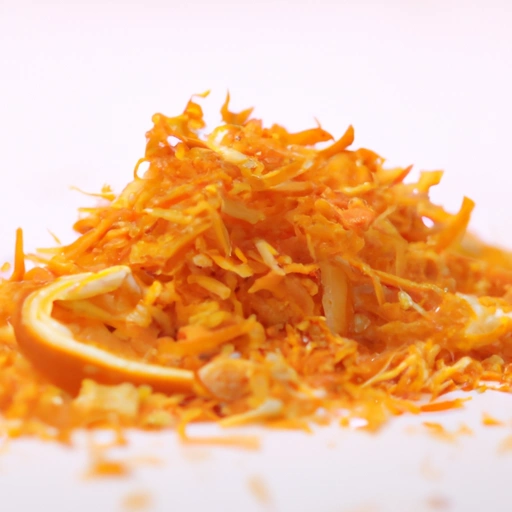Orange Zest
Description

Orange zest is the colorful outer layer of the peel of an orange. It is rich in essential oils that impart a vibrant citrus flavor and fragrance to a variety of dishes. When zesting an orange, it's important to remove only the thin colored layer and avoid the bitter white pith underneath. Orange zest can be grated in both fine and coarser textures, depending on the recipe's needs. Measurements for orange zest are usually given in teaspoons (tsp), tablespoons (tbsp), or grams (g), and in recipes from the United States, you might also find measurements in cups (1 cup = 237 milliliters).
Common uses
Orange zest is commonly used to enhance flavor in a wide range of culinary applications from baked goods such as cakes, cookies, and pastries, to savory dishes including marinades, dressings, and sauces. It also adds a decorative touch and intense flavor to cocktails and non-alcoholic beverages.
Nutritional value
Calories
Orange zest is low in calories, with 2 tablespoons (about 6 grams) containing only around 6 kcal.
Protein
It contains a negligible amount of protein, less than 0.1 grams per 2 tablespoons.
Fat
Orange zest has virtually no fat, with only trace amounts present.
Carbohydrates
The carbohydrate content is also low, with about 1.5 grams per 2 tablespoons of zest.
Vitamins
Orange zest is a good source of vitamin C and also contains small amounts of vitamins A and B.
Minerals
It provides minerals such as calcium, potassium, and magnesium in trace amounts.
Health benefits
Including orange zest in your diet can offer health benefits due to its high concentration of vitamin C, which is vital for immune function and skin health. The essential oils in the zest may have anti-inflammatory and antioxidant properties, potentially aiding digestion and improving heart health.
Potential risks
Consuming large amounts of orange zest may lead to digestive discomfort for some individuals. Additionally, it's important to source oranges that haven't been treated with pesticides or wash them thoroughly to reduce chemical exposure. Those with citrus allergies should also avoid orange zest.
Common recipes
Orange zest is featured in recipes like orange-glazed chicken, orange shortbread cookies, and orange pound cake. It's also a key ingredient in orange marmalade.
Cooking methods
Zest can be added directly to recipes without the need for cooking, or it can be cooked along with other ingredients to infuse its flavor.
Pairing with other ingredients
Orange zest pairs well with flavors such as almond, chocolate, cranberry, vanilla, and many spices, including cinnamon and cloves.
Summary
Orange zest is a versatile and flavorful ingredient that adds a fresh citrus note to both sweet and savory dishes. Its use spans various cuisines and offers a range of nutritional benefits, making it a beloved addition to cooking and baking around the world. With its bright color and intense flavor, orange zest can elevate the taste profile of your recipes.